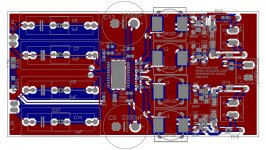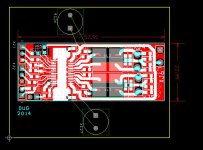TH Parts + S/D PIN + MUTE and Smaller Board Design [ 50 x 50mm ]
Keeping in-used the Shielded Inductors.
Layout Done and Summary Features:
- TH Parts
- S/D PIN
- MUTE PIN
- SYNC PIN ( For Multi-Boards Linkup e.g 2.1)
- BTL and PBTL Option
- Shielded Inductors [10 x10 mm]
- Board Size: 1.96" x 1.96" / 50 x 50 mm
Last edited:
Entering Saturnus orbit.
Calling Hong Kong, do you read?...copy...do you read?
What ?
He's just joking to Yuan Jing as they seem to copy their designs from here (or parts of it). Now Thor Ra calls for them to incorporate said changes in the design of Saturnus. If Yuan Jing copies the changes and make a final perfect version nobody here needs to make or produce a PCB 
Hiamplifier, where is the input connector on your new board ?
Hiamplifier, where is the input connector on your new board ?
Last edited:
Not to go too far off topic here, but, I am wondering if anyone out there has had the opportunity to compare any of the variations on these boards to the NCORE or similar "state of the art" class D amps. And for that matter any comparisons to other highly regarded amps solid state or tube? PS-It helps to know what speakers people are using. I'm planning on picking up some used OhmWalsh2 speakers and trying them out with my new Breeze. I'll let you all know.
There are no comparisons with the ebay boards to Ncore/other amps, but there are many reviews of the TBI Millenia Amp which is based on the older TPA3100D2. Several lengthy threads can be found here including favorable comparisons to Pass and Ncore amps and others.
What ?
Well, Yuan-jing seem to have copy a design of mine I posted in post #941, design wich it had a few errors as Saturnus pointed out, errors that they didnt correct.
So we think that posting our other designs they might want to copy it, that will safe us some work!!!... LoL... as someone said in some other post... its a tripple win!!...
Just finished the last draft of my updated 5x10cm design.
This board was designed with a main porpous, wich is the posibility of choosing diferent components at the inputs and in the LC and C-RC snubber filter, another
factor its to choose between the use of a filter or ferrite beads chips.
This board was designed with a main porpous, wich is the posibility of choosing diferent components at the inputs and in the LC and C-RC snubber filter, another
factor its to choose between the use of a filter or ferrite beads chips.
Attachments
Thanks Wushuliu that made for some interesting reading. I am guessing that the TPA 3116 is regarded as at least equal to the older TPA 3100. Is that your consensus as well?
Definitely.
Putting 50-470uf caps as close as possible is good. It's especially good for crunching room down and making it all small so you get real low inductance between input and output filters.
However none of these amplifiers sound worth a damn without significant capacitance behind them. Your ripple might be low, but your bass is going to suck without a LOT MORE power on tap. I don't suggest one large 15kuf cap, but rather using several 1000uf caps (I use 10x currently). It keeps the ESR/ESL low, and the bass high (and you can do it for $5 isntead of ludicrous amounts for fast big caps). Yeah the inductance isn't good, but the improved near-chip network of caps will help a lot.
It's a price worth paying. It's better to have them onboard, somewhere near the power in, so you can squeeze all the more critical small stuff in a tighter area. In fact even off board it's better to have them than not. I mean literally it's better to have them dangle on wires off the board than not at all. Without PSU capacitance class D is the flat and boring class (I know a guy using 20ah+ batteries to offset the issue, but no caps). Unfortunately it still lags a tiny bit behind class A, but I think we all know the little difference isn't so little on the electric bill.
However none of these amplifiers sound worth a damn without significant capacitance behind them. Your ripple might be low, but your bass is going to suck without a LOT MORE power on tap. I don't suggest one large 15kuf cap, but rather using several 1000uf caps (I use 10x currently). It keeps the ESR/ESL low, and the bass high (and you can do it for $5 isntead of ludicrous amounts for fast big caps). Yeah the inductance isn't good, but the improved near-chip network of caps will help a lot.
It's a price worth paying. It's better to have them onboard, somewhere near the power in, so you can squeeze all the more critical small stuff in a tighter area. In fact even off board it's better to have them than not. I mean literally it's better to have them dangle on wires off the board than not at all. Without PSU capacitance class D is the flat and boring class (I know a guy using 20ah+ batteries to offset the issue, but no caps). Unfortunately it still lags a tiny bit behind class A, but I think we all know the little difference isn't so little on the electric bill.
Last edited:
Well, Yuan-jing seem to have copy a design of mine I posted in post #941, design wich it had a few errors as Saturnus pointed out, errors that they didnt correct.
So we think that posting our other designs they might want to copy it, that will safe us some work!!!... LoL... as someone said in some other post... its a tripple win!!...
Thats amazing, so you guys are unpaid designers for Yuanjing?
Anyone here remember the days of 'tone controls' where you adjusted the sound to suit your own preferences, speaker shortfalls and listening environment?
Layout Done and Summary Features:
- TH Parts
- S/D PIN
- MUTE PIN
- SYNC PIN ( For Multi-Boards Linkup e.g 2.1)
- BTL and PBTL Option
- Shielded Inductors [10 x10 mm]
- Board Size: 1.96" x 1.96" / 50 x 50 mm

Just curious, are you going to build an amp using this board? I am interested to learn how it will sound. And if the amp is priced right, I might get one or two to try it out.
Regards,
Putting 50-470uf caps as close as possible is good. It's especially good for crunching room down and making it all small so you get real low inductance between input and output filters.
However none of these amplifiers sound worth a damn without significant capacitance behind them. Your ripple might be low, but your bass is going to suck without a LOT MORE power on tap. I don't suggest one large 15kuf cap, but rather using several 1000uf caps (I use 10x currently). It keeps the ESR/ESL low, and the bass high (and you can do it for $5 isntead of ludicrous amounts for fast big caps). Yeah the inductance isn't good, but the improved near-chip network of caps will help a lot.
It's a price worth paying. It's better to have them onboard, somewhere near the power in, so you can squeeze all the more critical small stuff in a tighter area. In fact even off board it's better to have them than not. I mean literally it's better to have them dangle on wires off the board than not at all. Without PSU capacitance class D is the flat and boring class (I know a guy using 20ah+ batteries to offset the issue, but no caps). Unfortunately it still lags a tiny bit behind class A, but I think we all know the little difference isn't so little on the electric bill.
Well, my experience of these 3116 amps are quite different from yours. When I first heard DUG's own design, I was totally blown away by the quality of the sound it is capable to deliver. Particularly, the base was amazing. I do not think there were much capacitance on DUG's board since it was very small.
I have the YJ 2.0 board and I like the base. It is tight and get pretty low. My speaker's spec is -3 db at ~mid 20 Hz (sensitivity is 87 dB). I do not feel anything is slacking. This is what attracted me to this amp, no big heat sink, big PS, ticky pairing of equipment, big price tags etc. and one can get good sound out of it.
I know some people spending big money on expensive caps, big caps, making changes to their amp that are supposed to improve the sound sound based on theory. At the end, the improvement in sound is either minimal or non-existence. Then they try more mods to the amp and the cycle keep going round and round.
Regards,
Isn't that the DIY motto....At the end, the improvement in sound is either minimal or non-existence. Then they try more mods to the amp and the cycle keep going round and round.
I know some people spending big money on expensive caps, big caps, making changes to their amp that are supposed to improve the sound sound based on theory. At the end, the improvement in sound is either minimal or non-existence. Then they try more mods to the amp and the cycle keep going round and round.
I've not yet seen anyone post up a theory of how more caps on the supply makes for better bass. If anyone has one I'd dearly love to read it. The people I have seen advocating more caps have based their suggestions on experiments - i.e. practice. I myself have done that experiment and found more caps leads to better bass so I'm with Destroyer OS on this.
Just curious, are you going to build an amp using this board? I am interested to learn how it will sound. And if the amp is priced right, I might get one or two to try it out.
Regards,
Some DIYers ask for TH parts and small size. Therefore, I make it for fun and use it in my new amp.
The DIY KIT is available at est. 19 Feb. if you want to have receive more information, Please PM.
Now the PCB factory and chips / parts suppliers are closed already in Chinese New Year Holiday period.
Last edited:
58 x 23?
Challenge accepted.
Except for the 470uF it fits.

Nice! What about the 33x23mm challenge ? Would it help to use those small 220uF SMT caps x 2 in parallel for each side to squeeze it all in? Also would using both sides of the board help?
- Home
- Amplifiers
- Class D
- TPA3116D2 Amp

